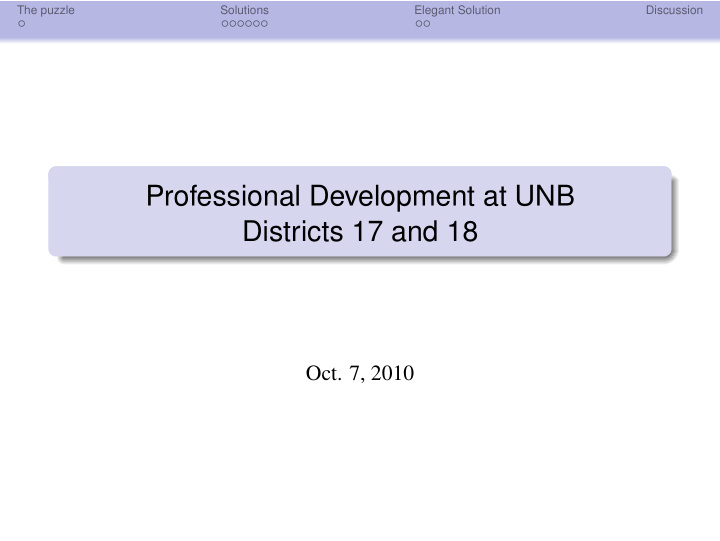



The puzzle Solutions Elegant Solution Discussion Professional Development at UNB Districts 17 and 18 Oct. 7, 2010
The puzzle Solutions Elegant Solution Discussion Outline The puzzle 1 Solutions 2 Elegant Solution 3 Discussion 4
The puzzle Solutions Elegant Solution Discussion Puzzle There’s a glass of wine and a glass of water. You transfer a dipper of the wine to the water glass, and then transfer back one dipper of the mixture to the wine glass. Question: Is there more wine in the water or water in the wine?
The puzzle Solutions Elegant Solution Discussion Algebraic Approach Let’s suppose the volume of wine and water is 90 ml, and the dipper holds 10 ml. We can calculate the amount of wine in the water as follows: • Start with 90 ml of 100% water. • When wine is added, we have 100 ml; 1/10 is wine. So the concentration of this mixture is 0.1. • When 10 ml of this mixture is transferred back to the wine glass, ( 10 ) · ( 0 . 1 ) = 1 ml of this is wine; hence the amount of wine left in the water is 10 ml - 1 ml = 9 ml.
The puzzle Solutions Elegant Solution Discussion Algebraic Approach Now, how much water is in the wine? • The dipper contained 1 ml of wine on its way back to the water glass... • so 9 ml must have been water. • Thus there are 9 ml of water in the wine.
The puzzle Solutions Elegant Solution Discussion Hmm... Conclude: the amount of wine in the water is the same as the amount of water in the wine. Was that obvious? Are these numbers special?
The puzzle Solutions Elegant Solution Discussion Generalize Let’s say we begin with 90 ml of each as before, but the amount we trade back and forth is not specified. Call it x . x • Middle step: concentration of wine in the water: 90 + x x • Amount of wine transferred back out: x · 90 + x x 2 90 x • Thus amount of wine left in the water is: x − 90 + x = 90 + x
The puzzle Solutions Elegant Solution Discussion Generalize How much water in the wine? x 2 • The dipper had 90 + x ml of wine in it. x 2 • So it must have had x − 90 + x ml of water. 90 x • There are 90 + x ml of water in the wine.
The puzzle Solutions Elegant Solution Discussion Hmm again. It doesn’t seem to matter how much we transfer; there is always the same amount of wine in the water as there is water in the wine. There are elegant solutions that don’t require any calculations at all.
The puzzle Solutions Elegant Solution Discussion Elegant Solution (This is paraphrased from D. Sauter.) • The dipper was full of wine on its first trip to the water glass. • Now it is partially full of wine on the return trip. • The amount of water in the dipper has to be exactly equal to the amount of wine left behind in the water glass. • After dumping it in the wine bucket, there will be exactly the same amount of water in the wine as wine in the water.
The puzzle Solutions Elegant Solution Discussion Elegant Solution Another one, due to Chris Reiss: Each bucket ends at the same level it started. Liquid is conserved, so wine and water must have been equally traded. Final one: After both transfers, imagine all the water in the wine glass floats together in a “blob”. Well, that blob of water has to have replaced an identical blob of wine that is now in the water glass.
The puzzle Solutions Elegant Solution Discussion Conclusion We now see that it doesn’t matter what the starting volumes are, or how much is transferred, or how many times you transfer. The only thing that matters is that volume is conserved in each glass. Does the algebra help your understanding of this puzzle? Does it hinder your understanding?
The puzzle Solutions Elegant Solution Discussion Discussion problems Is it possible in this scenario to end up with half water and half 1 wine in each glass? If so, how? If not, how could you change the problem to make it possible? Is it possible to end up with more than half wine in the water 2 glass? If so, how? If not, how could you change the problem to make it possible?
Appendix References I D. Sauter http://www.donaldsauter.com/wine.htm J. Leeming Fun With Puzzles , 1946. W. W. R. Ball Mathematical recreations and problems of past and present times , 1896.
Recommend
More recommend